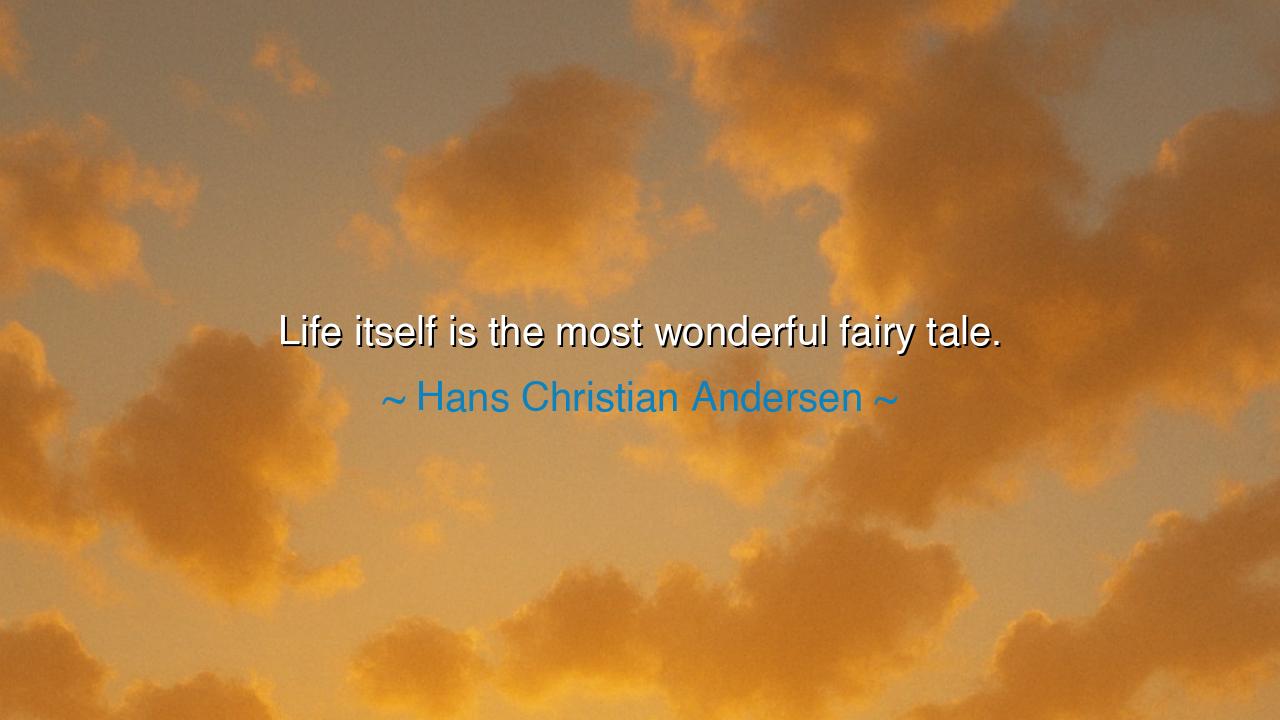
Life itself is the most wonderful fairy tale.






“Life itself is the most wonderful fairy tale.” — so spoke Hans Christian Andersen, the dreamer from Denmark whose stories taught the world that wonder hides within the simplest moments, and that even sorrow can carry the seeds of grace. These words, luminous and eternal, were not born from comfort or ease, but from a soul that had known poverty, rejection, and longing. Andersen’s life was no perfect tale of happiness, yet he saw within its struggles a kind of sacred storytelling — a pattern of light and shadow that, when viewed through the eyes of faith and imagination, became nothing less than a fairy tale written by existence itself.
The origin of this quote lies not in fantasy, but in truth. Andersen, who gave the world The Little Mermaid, The Ugly Duckling, and The Emperor’s New Clothes, often said that his own life was the story he never had to invent. Born the son of a poor shoemaker, he grew up in hardship, dreaming of worlds far beyond his reach. The path to success was steep and cruel; his art was ridiculed, his body frail, his heart often lonely. Yet through it all, he saw meaning. He once wrote, “My life is a lovely story, happy and blessed.” It was not because life spared him pain, but because he had learned to see beauty even in the struggle, to find magic in the mundane. In this, Andersen discovered a truth that few dare to embrace — that life itself, in all its imperfection, is the greatest story ever told.
To call life a fairy tale is not to deny its darkness, but to accept that within its darkness lies purpose. The greatest tales — those that have endured through centuries — are not merely about joy; they are about transformation. The hero must wander the forest, the mermaid must lose her voice, the swan must endure mockery before spreading its wings. So too is it with life: our hardships are not curses, but catalysts. They test us, shape us, and reveal the hidden majesty of the soul. Andersen knew this well, for his own story mirrored those he wrote — he was the “ugly duckling” who never stopped believing that beauty was waiting beyond the pain.
There is a lesson here as deep as it is gentle: that life’s value is not measured by comfort, but by wonder. To live fully is to look upon the ordinary with extraordinary eyes — to see the fairy tale hidden within the fabric of every day. The old man on the corner, the child chasing light through a puddle, the tears we shed in solitude — all are threads in the same enchanted tapestry. For those who see only misery, life is cruel; but for those who choose wonder, even sorrow has its melody. Andersen’s words remind us that we are not mere spectators, but characters in a living story, each day a new page, each trial a test of faith, and each joy a glimpse of eternity.
History gives us countless examples of those who lived this truth. Consider Helen Keller, blind and deaf from childhood, who nevertheless declared that life was “a grand adventure or nothing at all.” Her world, silent and dark, might have seemed stripped of beauty — yet through the touch of a teacher’s hand, she found connection, meaning, and joy. Her story, like Andersen’s, was not one of easy fortune, but of vision beyond sight — the same kind of spiritual seeing that transforms life into a wonderful fairy tale, where every obstacle becomes a doorway to revelation.
And so, Andersen’s wisdom is not the naïve optimism of a child, but the serene understanding of a sage. He teaches us that life’s enchantment lies not in perfection, but in perception. The heart that imagines, that believes, that endures — this is the true magician. Fairy tales endure not because they promise “happily ever after,” but because they reveal that every trial, every loss, every act of courage has meaning. So too does life. Its beauty lies not in the certainty of its ending, but in the wonder of its unfolding.
Therefore, my child, learn to live as Andersen did — with eyes that see the story behind the storm. When you stumble, remember that the hero always does before rising. When you face sorrow, remember that even the deepest pain is but one chapter, not the whole book. And when you find joy, hold it gently, knowing it is the light that gives all shadows shape.
Life itself is the most wonderful fairy tale — not because it is free of struggle, but because it is alive with mystery. Every breath is a page, every heart a story, every soul a song that longs to be heard. Walk through your days as if you are part of something sacred, for you are — and when you reach the final line of your tale, may it be said that you lived with wonder, and saw the world as Andersen saw it: not as it is, but as it could be, when the heart dares to dream.






AAdministratorAdministrator
Welcome, honored guests. Please leave a comment, we will respond soon